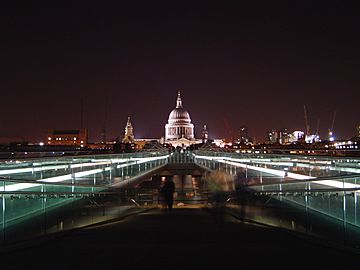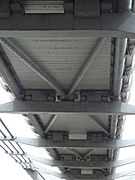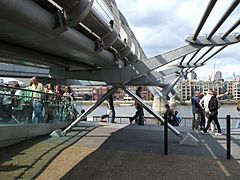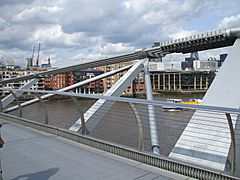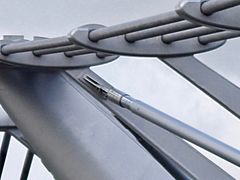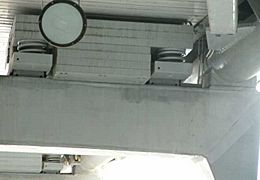Millennium Bridge, London facts for kids
Quick facts for kids Millennium Bridge |
|
|---|---|

The bridge seen from St Paul's Cathedral.
|
|
| Coordinates | 51°30′37″N 0°05′54″W / 51.510173°N 0.098438°W |
| Carries | Pedestrians |
| Crosses | River Thames |
| Locale | London |
| Official name | London Millennium Footbridge |
| Maintained by | Bridge House Estates, City of London Corporation |
| Preceded by | Blackfriars Railway Bridge |
| Followed by | Southwark Bridge |
| Characteristics | |
| Design | Suspension bridge |
| Total length | 325 metres (1,066 ft) |
| Width | 4 metres (13 ft) |
| Longest span | 144 metres (472 ft) |
| History | |
| Engineering design by | Arup |
| Constructed by | Monberg & Thorsen Sir Robert McAlpine |
| Opened | 10 June 2000 |
The Millennium Bridge, officially known as the London Millennium Footbridge, is a cool steel suspension bridge just for people walking. It crosses the famous River Thames in London. This bridge connects Bankside with the City of London. A group called Bridge House Estates looks after it.
Building the bridge started in 1998, and it first opened in June 2000. But on its opening day, people walking on it felt an odd swaying motion. Londoners quickly nicknamed it the "Wobbly Bridge". Because of this swaying, the bridge was closed later that day. After two days of limited use, it closed again for almost two years. Engineers worked hard to fix it and stop the wobbling. It finally reopened in February 2002.
The Millennium Bridge is located between Southwark Bridge and Blackfriars Railway Bridge. On its south side, you can find the Globe Theatre, the Bankside Gallery, and Tate Modern. On its north side, it's right next to the City of London School and St Paul's Cathedral. The bridge is built so that you get a perfect view of St Paul's Cathedral from across the river, framed by the bridge's supports.
Contents
Designing the Millennium Bridge
The way the Millennium Bridge looks was chosen through a special competition in 1996. This competition was set up by Southwark council and RIBA Competitions. The winning idea was called a "blade of light." It came from three groups: Arup Group, Foster and Partners, and Sir Anthony Caro.
To make sure the bridge didn't block views and wasn't too tall, its design is very flat. The cables that hold it up are actually below the walking path. The bridge has two piers (supports) in the river. It is made of three main parts that are 81 m (266 ft), 144 m (472 ft), and 108 m (354 ft) long. The total length of the bridge is 325 m (1,066 ft). The path you walk on is made of aluminum and is 4 m (13 ft) wide. Eight strong cables pull with a force of 2,000 tons against the piers. This is enough to hold up to 5,000 people on the bridge at one time!
Building the Bridge
Usually, building a bridge across the River Thames needs a special law from Parliament. But for the Millennium Bridge, they got permission in a different way. The Port of London Authority gave a license for the bridge. Also, the City of London and London Borough of Southwark gave building permission.
Construction started in late 1998. The main work began on April 28, 1999. The companies that built it were Monberg & Thorsen and Sir Robert McAlpine. The bridge ended up costing £18.2 million. Most of the money came from the Millennium Commission and the London Bridge Trust.
Opening Day and the Wobble
The Millennium Bridge opened to the public on June 10, 2000. It was two months later than planned.
But just two days after opening, on June 12, the bridge had to be closed. This was because it started to wobble sideways in an unexpected way. People tried to limit how many people were on the bridge at once, but it didn't stop the shaking. The closure of the bridge so soon after it opened caused a lot of talk. Many people saw it as another big British project for the new millennium that had problems, like the Millennium Dome.
Engineers later figured out that the wobbling was caused by something called "synchronous lateral excitation." This means that when many people walk on a bridge that sways a little, they naturally start to match their steps to the sway. This makes the bridge wobble even more! This is similar to how soldiers marching in step can make a bridge shake up and down. That's why soldiers are told to break step when crossing certain bridges, like London's Albert Bridge.
Why the Bridge Wobbled
The bridge's movements were caused by a "positive feedback" effect. This is when the natural sway of people walking caused small side-to-side movements in the bridge. Then, people on the bridge would sway in time with it to keep their balance. This made the bridge's movements bigger and bigger. At its worst, the bridge swayed about 70 millimeters (about 2.7 inches) from side to side. On opening day, 90,000 people crossed the bridge, with up to 2,000 people on it at any one time.
Engineers usually know about bridges shaking up and down from things like trains or wind. But they didn't expect this side-to-side movement caused by people walking. When the bridge moved to one side, everyone had to adjust their balance at the same time. This made the wobbling worse, like soldiers marching in step, but sideways.
Other bridges have had similar wobbling problems, especially lightweight ones. If a bridge can sway sideways at a certain speed and isn't very heavy, it can wobble a lot if enough people are on it. The more people, the bigger the wobbles. Some other bridges that had similar issues include:
- The Auckland Harbour Bridge in 1975.
- The Birmingham NEC Link bridge.
How They Fixed the Wobble
Engineers at Arup, the company that designed the bridge, studied this unexpected wobbling. They called it "synchronous lateral excitation." First, they did tests in labs with people walking on moving platforms. Later in 2000, they put special sensors on one part of the bridge. They then tested it with crowds of up to 275 people.
They found that making the bridge stiffer would change its look too much. So, they decided to control the wobbling by adding special devices called dampers. These dampers absorb energy and stop the shaking. They added 37 of these dampers.
- 17 "chevron dampers" were placed under the deck to control side-to-side movement.
- 4 "vertical to ground dampers" helped control both side-to-side and up-and-down movements.
- 16 "pier dampers" controlled side-to-side and twisting movements.
- Also, 52 "tuned mass dampers" were added to help control up-and-down movement.
This repair work took from May 2001 to January 2002 and cost £5 million. After more tests, the bridge reopened on February 22, 2002. Since then, it hasn't wobbled much. Even though it's fixed, Londoners still lovingly call it the "wobbly bridge."
- Dampers
Millennium Inclinator
Next to the northern end of the Millennium Bridge, there's a short lift called the Millennium Inclinator. It opened in December 2003. This lift helps people get up the steep hill (Peter's Hill) from the riverbank to the bridge entrance. It's especially useful for people who find stairs difficult, like those with disabilities or parents with push chairs.
The lift was updated in 2012. It was ready for the Thames Diamond Jubilee Pageant in June 2012 and the 2012 Summer Olympics that followed.
Images for kids
See also
 In Spanish: Millennium Bridge para niños
In Spanish: Millennium Bridge para niños


